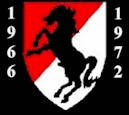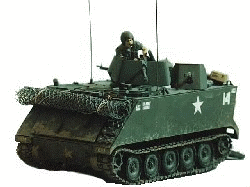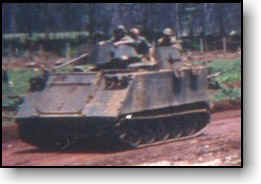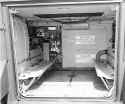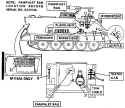|
Home | Photos |Facebook| Taps
HonorRoll | Base Camp | Reunions
Absent Comrades | Contributor's Corner
The Motor Pool
M113 ACAV
Armored Cavalry Assault VehicleModified For Use in Vietnam
Known as the "Green dragon" to the Viet Cong in the early stages of the war in Vietnam, the M113 was destined to become one of the most successful armored vehicles of all time. Seeing action in Vietnam on a wide scale from the DMZ to the Delta.
In 1962 the first M113s arrived in Vietnam and were given to ARVN units. In March 1962 a consignment of 32 M113s that were on their way to Europe were diverted and also given to the ARVN.
These first M113s were powered by a 209HP Chrysler 75M gasoline engine. By 1964 the M113 had been superceded by the updated M113A1. The M113A1 was fitted with a General motor's 215HP Diesel engine which gave it an improved performance over the earlier M113.
When I arrived in K Troop in April of 1968 the M-113 had already been outfitted with the "A Kit". This modification changed the classification of the ACAV to the M-113A. The kit included hatch armor, a .50 Caliber gun shield, two, elbow pintle mounts (left & right) with gun shields for the M60 (7.62 cal.) machine gun and a third removable M60 pintle mount on the rear hatch as an alternate mount for rear firing. Although not part of the kit, many crews lined the floor of the M-113A with sandbags. This was designed to afforded added protection against mines as described in detail below.
Crew:
Each M113 had a crew of two, a commander and a driver, and could carry eleven men and their equipment. The driver sat on the L/H side of the vehicle, and had a good field of vision through four periscopes which were mounted in the cupola. The commander was situated centrally in the vehicle and had a fully rotating cupola with five periscopes. The commander also acted as the gunner and operated the .50 cal machine gun, this could be rotated through a full 360 degrees to give an all-round field of fire if needed. The ammo for the 50 was stored in portable boxes behind the infantrymen's seats.
Originally the .50 cal gunners position was exposed and VERY unprotected. After the battle on Jan 2nd 1963 at Ap Bac, (in which fourteen ARVN M113 gunners had been killed) a combination shield and turret was designed which afforded much needed protection. This eventually was fitted as standard to all M113s.
Armor, Wheels and Tracks:
The cold rolled alloy hull of the M113 was made from Aluminum, Manganese and Magnesium. It's armor thickness varied from 3/4" to a maximum thickness of 1 1/4". This thickness provided protection from small arms fire and shell fragments, but would not stop a round from the soviet made RPG-7, or withstand the blast from a land mine.
One of the best features of the M113 was it's ability to operate in an amphibious roll with out the need of specialist preparation. The hull of the M113 was constructed as a watertight unit, with all hatches and doors fitted with rubber seals to make them watertight. The front of the vehicle was fitted with a hinged breakwater plate which helped to stabilize the vehicle during operations through water.
In the amphibious role the M113 was propelled by it's tracks, this was further enhanced by the rubber track shroud on each side of the hull, giving the M113 a top speed of 3 mph through water.
The 63-64 link tracks were 15" wide and of a swivel link type, housed in rubber bushings to give them maximum elasticity. The tracks themselves ran on ten pairs ( 5 each side) of 24" Aluminum road wheels which were in turn each fitted with a solid rubber tire 2 1/8" thick.
The track life span on the M113 was supposed to be about 3,000 miles, but this was regularly exceeded, and has been known to go as high as 9,000 miles.
ACAV
In 1965/66 some of the first M113s were converted into ACAVs (Armored Cavalry Assault Vehicle) by fitting them with side mounted M60s and gun shields. Sandbags were placed on the floor of the inner troop compartment to absorb some of the blast from land mines. Sandbags were also placed on the outer hull and arranged as parapets around the troop compartment so as to allow the infantry to fire over the sides. As well as using sandbags for absorbing the blast from mines, ACAVs were also fitted with Titanium plates beneath the belly for the same reason.
Other modes to change the M113 into ACAVs involved ripping out all but the drivers seat, to make more room for the carrying of essentials like loads of ammo. The ammo was stacked two layers deep, and wall-to-wall in the troop compartment. As well as as much ammo as they could carry the ACAVs space was also filled with the crew's kit bags, spare gun barrels, water, C-rations, crew weapons, grenades, tool box, and a set of towing cables.
At a mere $22,000 per vehicle, the U.S Army had come up with a good all round light armored vehicle. The M113 proved to be an excellent and effective armored fighting vehicle that went anywhere in Vietnam and did everything - and more besides!
| Crew | 2 + 11 |
| Weight (loaded) | 22,615lb |
| Weight (unloaded) | 19,755lb |
| Length | 191.5" |
| Width | 105.75" |
| Height | 86.5" |
| Clearance | 16" |
| Suspension | Torsion Bar |
| Speed | 44mph |
| Radius | 200 miles |
| Engine | GM 215HP Diesel |
| HP | 215 |
| Fuel cap | 95 Gal |
| Armament | 1-.50 Cal. Machine Gun 2- M60 Machine Guns 1-M79 Grenade Launcher M16 Rifle - each crewman |
| Optional Armament |
Hand grenades Claymore mines LAW (Anti Tank Weapon) |
| Armor | 0.75" - 1.25" |
| Basic Load | 1,500 .50 Cal. rounds 12,000 M60 rounds 120 M79 grenades |
Home | Base Camp | Photos |
Guest Book | Taps | Contributor's Corner
Honor Roll | Links | Feed Back | Reunions | Search | Site Map

